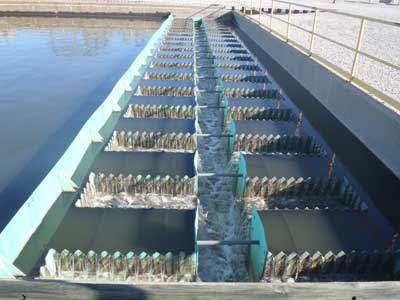Primary Treatment
Flocculation Chambers
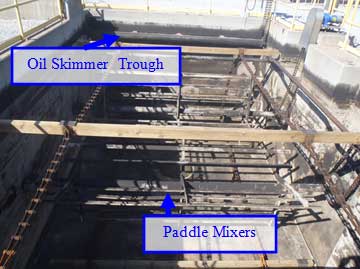 The flocculation chambers are located just before the clarifiers. They contain three slowly rotating paddle mixers and an oil skimmer trough. The purpose of the chambers is to aid in flocculation. Flocculation is the formation of clumps of solids, or flocs, in the wastewater. Prior to entering the flocculation chambers, a liquid polymer is added to the wastewater. This is a chemical that helps the solids to clump together. The paddle mixers slowly mix the wastewater allowing flocs to form. Once in the clarifier, these flocs will settle to the bottom as sludge.
The flocculation chambers are located just before the clarifiers. They contain three slowly rotating paddle mixers and an oil skimmer trough. The purpose of the chambers is to aid in flocculation. Flocculation is the formation of clumps of solids, or flocs, in the wastewater. Prior to entering the flocculation chambers, a liquid polymer is added to the wastewater. This is a chemical that helps the solids to clump together. The paddle mixers slowly mix the wastewater allowing flocs to form. Once in the clarifier, these flocs will settle to the bottom as sludge.
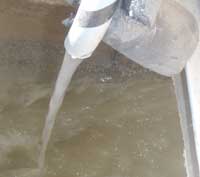
PChem Clarifiers
Just like the clarifiers at American Bottoms, the primary purpose of the clarifiers at PChem is to settle out heavy solids. Unlike those at American Bottoms, the clarifiers at PChem are rectangular. Wastewater flows into one end, and flows out over v-notched weirs at the opposite end. As the water travels across the clarifier, the heavy solids fall to the bottom.
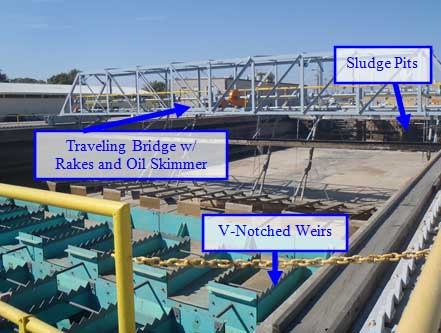
PChem Clarifier: Traveling Bridge
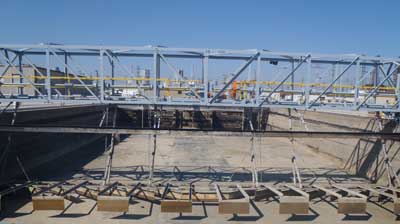 Each of the two clarifiers at PChem is equipped with a traveling bridge. The bridge has a set of rakes and an oil skimmer arm attached. The rakes scrape the bottom of clarifier, bringing sludge back towards the sludge pits for disposal. The oil skimmer arm carries floating solids back to an oil skimmer trough. The bridge travels the length of the clarifier very slowly so it doesn’t stir up the sludge settled on the bottom.
Each of the two clarifiers at PChem is equipped with a traveling bridge. The bridge has a set of rakes and an oil skimmer arm attached. The rakes scrape the bottom of clarifier, bringing sludge back towards the sludge pits for disposal. The oil skimmer arm carries floating solids back to an oil skimmer trough. The bridge travels the length of the clarifier very slowly so it doesn’t stir up the sludge settled on the bottom.
PChem Clarifier: Sludge Pits
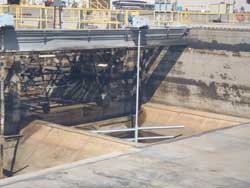 The sludge pits are located at the same end of the clarifier that the wastewater first enters. The rakes push the sludge towards the sludge pits. At times, the sludge at the bottom of the clarifiers is very thick and heavy. Gently turning mixers are installed above the sludge pits to keep the sludge moving to the bottom of the pits so it can be pumped out and sent to the dewatering process.
The sludge pits are located at the same end of the clarifier that the wastewater first enters. The rakes push the sludge towards the sludge pits. At times, the sludge at the bottom of the clarifiers is very thick and heavy. Gently turning mixers are installed above the sludge pits to keep the sludge moving to the bottom of the pits so it can be pumped out and sent to the dewatering process.
PChem Clarifier: V-Notched Weirs
PC-Primary-Details-6-web.jpgV-notched weirs line the east end of the clarifiers at PChem. These weirs ensure the water flowing out of the clarifiers is evenly distributed. Maintaining an even flow at the end of the clarifier keeps the water calm. This keeps the heavy solids from being disturbed as they fall to the bottom of the clarifier
